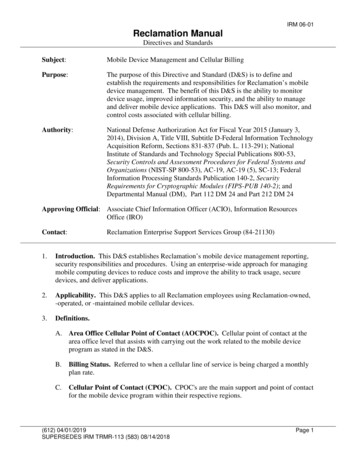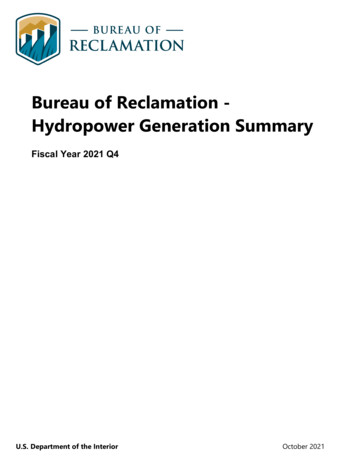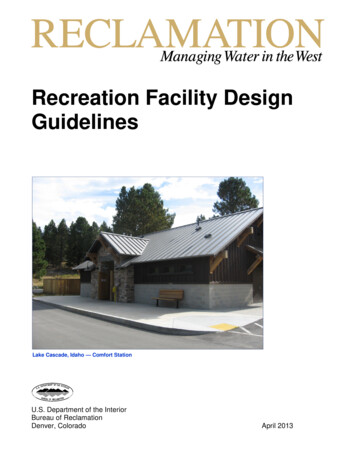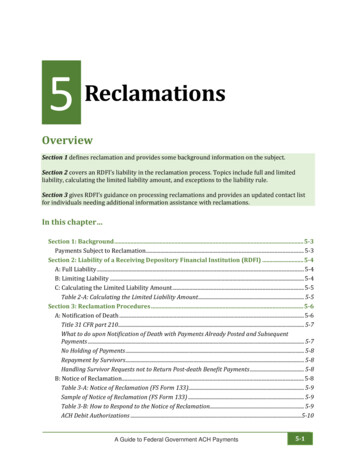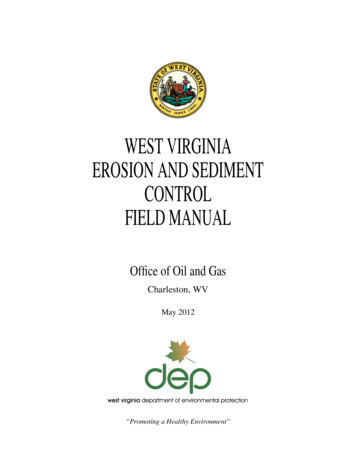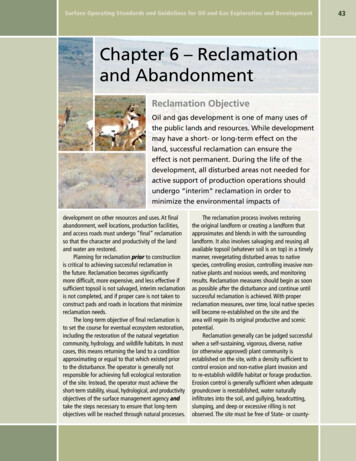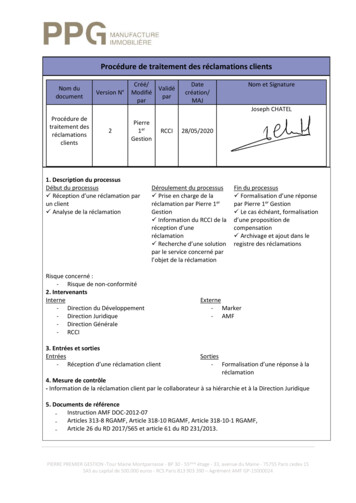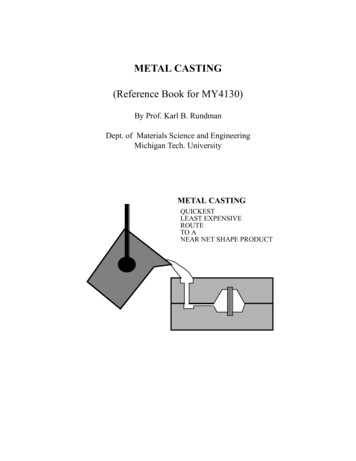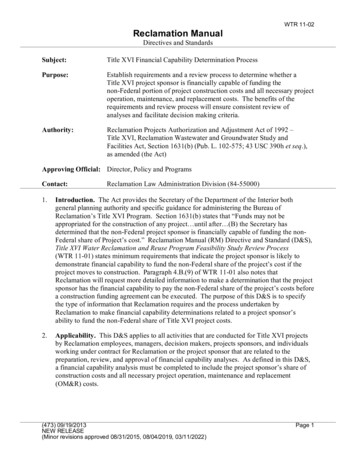
Transcription
Reclamation ManualWTR 11-02Directives and StandardsSubject:Title XVI Financial Capability Determination ProcessPurpose:Establish requirements and a review process to determine whether aTitle XVI project sponsor is financially capable of funding thenon-Federal portion of project construction costs and all necessary projectoperation, maintenance, and replacement costs. The benefits of therequirements and review process will ensure consistent review ofanalyses and facilitate decision making criteria.Authority:Reclamation Projects Authorization and Adjustment Act of 1992 –Title XVI, Reclamation Wastewater and Groundwater Study andFacilities Act, Section 1631(b) (Pub. L. 102-575; 43 USC 390h et seq.),as amended (the Act)Approving Official: Director, Policy and ProgramsContact:Reclamation Law Administration Division (84-55000)1.Introduction. The Act provides the Secretary of the Department of the Interior bothgeneral planning authority and specific guidance for administering the Bureau ofReclamation’s Title XVI Program. Section 1631(b) states that “Funds may not beappropriated for the construction of any project until after (B) the Secretary hasdetermined that the non-Federal project sponsor is financially capable of funding the nonFederal share of Project’s cost.” Reclamation Manual (RM) Directive and Standard (D&S),Title XVI Water Reclamation and Reuse Program Feasibility Study Review Process(WTR 11-01) states minimum requirements that indicate the project sponsor is likely todemonstrate financial capability to fund the non-Federal share of the project’s cost if theproject moves to construction. Paragraph 4.B.(9) of WTR 11-01 also notes thatReclamation will request more detailed information to make a determination that the projectsponsor has the financial capability to pay the non-Federal share of the project’s costs beforea construction funding agreement can be executed. The purpose of this D&S is to specifythe type of information that Reclamation requires and the process undertaken byReclamation to make financial capability determinations related to a project sponsor’sability to fund the non-Federal share of Title XVI project costs.2.Applicability. This D&S applies to all activities that are conducted for Title XVI projectsby Reclamation employees, managers, decision makers, projects sponsors, and individualsworking under contract for Reclamation or the project sponsor that are related to thepreparation, review, and approval of financial capability analyses. As defined in this D&S,a financial capability analysis must be completed to include the project sponsor’s share ofconstruction costs and all necessary project operation, maintenance and replacement(OM&R) costs.(473) 09/19/2013NEW RELEASE(Minor revisions approved 08/31/2015, 08/04/2019, 03/11/2022)Page 1
Reclamation ManualWTR 11-02Directives and Standards3.Information Necessary to Analyze Financial Capability. Reclamation will work with theproject sponsors to ensure that it has the information necessary to make a determination offinancial capability. The following information is required:A. estimated non-Federal portion of the costs of the project associated with constructionand annual OM&R activities;B.a calculated debt service coverage ratio;C.bond rating and issuer credit rating;D. financial statement analysis (to include previous 3 years of financial statements);E.F.information on socio-economic indicators of the project region, including:(1)unemployment;(2)median household income; and(3)property values;estimated average monthly cost of water for the project sponsor with and without theproject in place;G. estimated average monthly cost of water for other water entities within the region; andH. primary source of revenue to fund the Title XVI project construction.4.Requirements Necessary to Make a Determination of Financial Capability. A two-stepapproach to financial capability analysis will be followed in determining whether or not asponsor is financially capable of funding the non-Federal share of a project’s constructionand OM&R costs. See Appendix A for the Title XVI Financial Capability Decision Treeillustrating this two-step approach.A. Primary Analysis – Bond Rating or Issuer Credit Rating and Debt ServiceCoverage Ratio. A primary analysis will be conducted looking at the projectsponsor’s bond rating or issuer credit rating and its debt service coverage ratio. Thebond rating or issuer credit rating comparison shown in Table A includes the creditrating agencies from which Reclamation will accept ratings from and the correspondingacceptable versus unacceptable ratings. The debt service coverage ratio ratings shownin Table B include an acceptable and unacceptable range of ratios. Financialstatements of the project sponsor(s) will be analyzed to verify that the bond rating orissuer credit rating and the debt service coverage ratio are in the acceptable range.(1)Bond Rating or Issuer Credit Rating. Any Title XVI sponsor utilizing eitherbonds or debt to fund its portion of the project must submit its bond rating or(473) 09/19/2013NEW RELEASE(Minor revisions approved 08/31/2015, 08/04/2019, 03/11/2022)Page 2
Reclamation ManualWTR 11-02Directives and Standardsissuer credit rating. Reclamation will only accept a bond rating or issuer creditrating for financial capability that is investment grade (see Table A below). Theparameters for bond rating and issuer credit ratings are as follows:(a) A high bond rating or issuer credit rating means that even under adverseeconomic conditions, such as a recession, the overall capability of thesponsor to meet its financial obligation is strong.(b) A medium bond rating or issuer credit rating means that an obligation hasadequate protection, but that adverse economic conditions could weakencommitment to meet an obligation.(c) An unacceptable bond rating or issuer credit rating indicates potentialvulnerability to adverse economic conditions and possible inability to meetthe financial commitment on an obligation. A speculative bond rating orissuer credit rating is considered unacceptable.(d) The bond rating or issuer credit rating must be no more than 3 years old to beconsidered current.(e) If a current bond rating or issuer credit rating is not available from a NRSROagency, a current credit rating with supporting documentation from a lendercoupled with the analyst’s verification of the credit rating must be combinedwith a rigorous secondary analysis.(f) Projects that are funded entirely by capital improvement funds (fundscurrently on the sponsor’s balance sheet approved for capital improvementprojects consistent with the proposed project) will be exempt from therequirement for a bond rating or issuer credit rating analysis and will beaccorded an acceptable high rating.Table A – Sample Bond Rating or Issuer Credit Rating Comparison by Rating AgencyRatingAgencyStandard and Poor’sMoody’sFitch RatingsAcceptable (Investment Grade)HighMediumAAA, AA, ABBBAaa, Aa, ABaa3AAA, AA, ABBB-(473) 09/19/2013NEW RELEASE(Minor revisions approved 08/31/2015, 08/04/2019, 03/11/2022)Unacceptable (Speculative)BB , B, CCC, CC, C, DBa1, B, Caa, Ca, CBB , B, CCC, DDD, DD, DPage 3
Reclamation ManualWTR 11-02Directives and Standards(2)Debt Service Coverage Ratio. The formula and description to calculate the debtservice coverage ratio is:(a) Debt Service Coverage Ratio Net Cash Operating Income1Annual Debt Service(b) A debt service coverage ratio for the project sponsor must be at least 1.0 for5 years beginning when the project is placed in service or repayment begins,to meet the minimum requirements for financial capability. If a ratio iscurrently or projected to be less than 1.0 within the initial 5-year period, aplan to meet the shortfall during this initial period and additional analysismust be provided to document that the ratio will increase to 1.0 or greaterand remain above 1.0 for an additional 5-year period. The debt servicecoverage ratio ratings are shown in Table B.Table B – Debt Service Coverage Ratio RatingsDebt Service AcceptableUnacceptableHigh MediumRatio 2.0 1.0 to 2.0 1.0(3)Title XVI Projects with Multiple Non-Federal Sponsors. For Title XVIprojects with more than one non-Federal project sponsor, each sponsor mustprovide documentation of an acceptable bond rating or issuer credit rating and/ordebt service coverage ratio as described above. However, if a project sponsor or aportion of the project sponsors submit documentation that they have acceptableratings and ratios to meet the financial capability criteria for the entire project, thesponsor(s) must submit documentation and proof that they are willing to acceptfinancial responsibility for the entire project. If the sponsors with acceptableratings and ratios cannot (or will not) meet the financial capability criteria for theentire project, then the overall bond rating or issuer credit rating and debt servicecoverage ratio will be considered unacceptable.(4)Financial Statement Analysis. Audited financial statements from the sponsorwill be reviewed for the most recent 3-year period. A comparison of the datafrom the financial statements and accompanying notes will be made to determineconsistency with the information presented in the bond rating or issuer creditrating and the debt service coverage ratio analyses. Any qualified opinions 2,inconsistencies, or issues that raise concerns identified in the analysis of theIn addition to the project sponsor’s Net Cash Operating Income, all income and revenues that could be used towardrepayment of a water supply project will be included in the debt service coverage ratio analysis.2A qualified opinion is a statement issued by a professional auditor. A qualified opinion suggests that theinformation provided was limited in scope and/or the entity being audited has not maintained generally acceptedaccounting principles.1(473) 09/19/2013NEW RELEASE(Minor revisions approved 08/31/2015, 08/04/2019, 03/11/2022)Page 4
Reclamation ManualWTR 11-02Directives and Standardsfinancial statements must be addressed before proceeding with further analysis ofthe sponsor’s financial capability. Qualified opinions and inconsistencies requirea rigorous secondary analysis be performed.(5)Outcome of Primary Analysis. A matrix of the possible outcomes of theprimary analysis is shown in Table C. The possible outcomes include:(a) If the bond rating or issuer credit rating for the project sponsor is in theacceptable high range, the debt service coverage ratio is in the acceptablehigh range, and the financial statement analysis shows consistency with theseresults without a qualified opinion, then a cursory secondary analysis will beperformed to confirm that the project area is not experiencing severe adverseconditions that could negatively affect financial capability.(b) If the bond rating or issuer credit rating is in the acceptable medium range,the debt service coverage ratio is in the acceptable medium range, or thefinancial statement shows inconsistency with these results with a qualifiedopinion, then a rigorous secondary analysis will be performed to evaluatefinancial capability.(c) If the bond rating or issuer credit rating is unacceptable, the project sponsorwill be found not financially capable of funding the non-Federal share of theTitle XVI project.(d) If the debt service coverage ratio is unacceptable (below 1.0), an additionalanalysis must be completed (see Paragraph 4.A.(2)(b) above). If, during thisadditional analysis, the debt service coverage ratio stays below 1.0 for theentire 5-year period beginning when the project would be placed in serviceor repayment begins, then a determination will be made that the projectsponsor is not financially capable. However, if the analysis shows the debtservice coverage ratio rising above 1.0 within the initial 5-year period andremaining there for an additional 5 consecutive years, then a rigoroussecondary analysis must be performed to determine financial capability.(473) 09/19/2013NEW RELEASE(Minor revisions approved 08/31/2015, 08/04/2019, 03/11/2022)Page 5
WTR 11-02Reclamation ManualDirectives and StandardsTable C – Primary Analysis MatrixPrimary AnalysisMatrixDebt ServiceCoverageRatio (Ratio)– AcceptableRatioUnacceptableB.HighBond Rating or Issuer CreditRating – AcceptableHighMediumCursorySecondaryAnalysisMedium leBond Ratingor IssuerCredit Rating– condary Analysis – Additional Economic and Financial Indicators. Thesecondary analysis will be cursory or rigorous depending on the outcome of theprimary analysis. In a cursory secondary analysis, an analysis of the socio-economicindicators in the project region will be conducted. In addition to analyzing the socioeconomic indicators of the project region, a rigorous secondary analysis includes waterservice affordability, rate comparison, and rate shock analyses. The results of thesecondary analysis on the overall determination will depend on the outcome of thefollowing Paragraphs (see Table D below).(1)Socio-economic Indicators of the Project Region. The relative importance ofgeneral economic conditions depends, to some degree, on the source of funds forthe proposed project and the professional judgment of the reviewing analyst. Ifthe primary source of revenue for the project sponsor is from fees and watercharges, then income and unemployment data and trends are most relevant. Ifproperty-based assessments are the primary sources of revenue, then propertyvalues and trends in property values are most relevant. Ratings by economicindicator are shown below in Table D.(2)Water Service Affordability. The U.S. Environmental Protection Agency(EPA) has indicated in previous studies that a combined water and sewer bill inexcess of 4.5 percent of annual median household income is considered thebenchmark for affordability, with 2.5 percent of annual median household incomeallowed for water supply costs. An estimated percentage of 2.5 percent of annualmedian household income does not necessarily indicate the maximum amounthouseholds could pay for water supplies, but is an indicator of the threshold above(473) 09/19/2013NEW RELEASE(Minor revisions approved 08/31/2015, 08/04/2019, 03/11/2022)Page 6
Reclamation ManualWTR 11-02Directives and Standardswhich the potential for economic hardship increases. The criterion for waterservice affordability is shown in Table D. The following criteria apply to waterservice affordability:(a) Water supply costs below 2.5 percent of annual median household incomehave a water service affordability rating of good.(b) Reclamation considers an amount between 2.5 and 6.5 percent3 of annualmedian household income to have a water service affordability rating ofmedium and could be affordable, but payment of these costs could reduceother types of household spending.(c) An affordability rating above 6.5 percent is considered poor, and adetermination will be made that the sponsor is not financially capable.(3)Rate Comparison. In a rate comparison analysis, rates of feasible alternativesources for water are examined; where they are less than the proposed projectrates, a medium or poor rating is given and further justification for the project willbe required. Where proposed project rates are competitive or below rates ofalternative sources of water, a good rating is given. The criterion for the ratecomparison analysis is shown in Table D.(4)Rate Shock. In a rate shock analysis, potential negative public reactions topotential rate shocks are assessed by evaluating estimated percentage changes inrates, not necessarily rate levels.4 Reclamation’s criteria on rate shock analysisare shown in Table D below, which classifies water rate increases of more than200 percent as medium or poor indicators, regardless of the percentage of annualmedian household income necessary to pay water bills. This indicator must beconsidered in combination with socio-economic indicators, water serviceaffordability, and rate comparison.Data from the Bureau of Economic Analysis, U.S. Department of Commerce, for the period of 1990 through 2009indicates that personal savings as a percentage of personal income has averaged about 5.62 percent. Data from theAmerican Housing Survey from 1995 through 2009 indicates that an average water bill for all U.S. households wasapproximately 0.914 percent of median household income. Therefore, assuming that savings represents maximumavailable household income for additional water service charges, 6.5 percent of household income is considered themaximum affordable water service.4Studies conducted by the EPA on water supply affordability suggest that water rate increases, or shocks, of 100 to200 percent may be a sign of questionable affordability and that increases of 200 percent or more may beunaffordable.3(473) 09/19/2013NEW RELEASE(Minor revisions approved 08/31/2015, 08/04/2019, 03/11/2022)Page 7
Reclamation ManualWTR 11-02Directives and Standards(5)Outcome of Secondary Analysis 5. The possible ratings for socio-economicindicators, water service affordability, rate comparison, and rate shock are shownin Table D below. The possible outcomes for the secondary analysis include thefollowing:(a) Poor socio-economic indicator ratings combined with minimally acceptablefindings of the primary analysis and marginal affordability will result inunacceptable overall financial capability.(b) If the results of the cursory secondary analysis for all three socio-economicindicators (unemployment, median household income, and property values)are good, then a determination will be made that the project sponsor isfinancially capable. Otherwise, a rigorous secondary analysis must beperformed.(c) If the results of the cursory secondary analysis reveal that any of thesocio-economic indicators are not good (medium or poor), a rigoroussecondary analysis must be performed for water service affordability, ratecomparison, and rate shock. If these three indicators are good, then adetermination will be made that the project sponsor is financially capable.Alternatively, if these three indicators are medium or poor, then additionalanalysis or documentation that the project sponsor's financial condition isstrong must be provided to justify the analyst's recommendation regarding aproject sponsor's financial capability to the regional director. Lastly, if thesethree indicators are poor, then the determination will be made that the projectsponsor is not financially capable to pay the Title XVI project costs.(d) In the rigorous secondary analysis, if all regional socio-economic indicators,water service affordability, rate comparison, and rate shock analyses aregood (see Table D), then a determination will be made that the projectsponsor is financially capable.(e) If the outcome of any or all of the four analyses described in Table D iseither medium or poor, then additional analyses or documentation that theproject sponsor’s financial condition is strong must be provided to justify theanalyst’s recommendation regarding a project sponsor’s financial capabilityto the regional director.If the primary requirements for bond rating or issuer credit rating and debt service coverage ratio are onlyminimally acceptable (for example a BBB- Standard and Poor’s rating and 1.05 debt service coverage ratio) andwater service affordability is questionable (for example water service will be 5.5 percent of median householdincome and water rates will increase 200 percent), then the general socio-economic indicators can be used todetermine if only marginal acceptance will likely decline into an unacceptable range. That is, if all three socioeconomic indicators are poor, then the ability to cover debt will likely decline and the cost of water service as apercentage of median household income will increase.5(473) 09/19/2013NEW RELEASE(Minor revisions approved 08/31/2015, 08/04/2019, 03/11/2022)Page 8
Reclamation ManualWTR 11-02Directives and Standards(f) If the water service affordability analysis results in an affordability thresholdof greater than 6.5 percent (poor), then the determination will be made thatthe project sponsor is not financially capable to pay the Title XVI projectcosts.Table D – Secondary AnalysisSecondary AnalysisSocioUnemploymenteconomicIndicators ofthe ProjectRegion –Current andTrend OverLast 10 YearsMedianHouseholdIncomePropertyValuesGoodBelow the stateaverage anddeclining or stabletrendAbove stateaverage and stableor increasing trendAbove stateaverage and stableor increasing trendWater Service AffordabilityLess than 2.5percent medianhousehold incomeRate ComparisonAlternative sourcesof water rates proposed waterratesWater rate increase 200 percentRate Shock5.MediumAt or within1 percent abovestate average butdeclining trend orbelow stateaverage butincreasing trendWithin 25 percentof state averageand stable orincreasing trendAt or above stateaverage anddecreasing trend orbelow stateaverage butincreasing trendBetween 2.5 and6.5 percent medianhousehold incomePoorMore than1 percent abovestate average or atstate average butincreasing trend25 percent or morebelow stateaverage or 10percent below stateaverage and adecreasing trendBelow stateaverage anddecreasing TrendGreater than 6.5percent medianhousehold income(NOTFINANCIALLYCAPABLE)Alternative sources of water rates proposed ratesWater rate increase 200 percentProcess for the Review of Financial Capability Documentation.A. Reviewing Office. The regional director will designate a reviewing office. Thereviewing office will facilitate the review of financial capability documentation byestablishing a schedule, coordinating meetings, providing documents to Reclamation(473) 09/19/2013NEW RELEASE(Minor revisions approved 08/31/2015, 08/04/2019, 03/11/2022)Page 9
Reclamation ManualWTR 11-02Directives and Standardsstaff involved in the review of documentation, and communicating with the projectsponsor. The reviewing office will determine who will be the reviewing analyst andwill provide the funding necessary to perform the review.B.C.Review Initiation. Within 15 days from when the project sponsor submits thedocumentation described in Paragraph 3 of this D&S to the appropriate Reclamationregional or area office, the reviewing office will examine the documentation providedin order to identify any missing significant items. This review is intended to be aquick-check to determine whether each item required by Paragraph 3 has been includedfor Reclamation review.(1)If the financial capability documentation is incomplete, the reviewing office willnotify the project sponsor, in writing, of the items that need to be included forreview.(2)If the financial capability documentation includes all of the items listed inParagraph 3, the reviewing office will notify the project sponsor, in writing, thatreview of the documentation will be initiated and will identify Reclamation staffto conduct the financial capability analysis.Review of the Financial Capability Documentation.(1)The reviewing analyst will examine the documentation provided by the projectsponsor as required in Paragraph 3 to determine whether it meets all of therequirements of Paragraph 4 of this D&S.(2)If the documentation is found to be inadequate, the reviewing analyst will informthe reviewing office what additional information is required. The reviewingoffice will request any necessary additional information from the project sponsorin writing.(3)Prior to making a final determination, the reviewing analyst will provide draftfindings for peer review in accordance with RM Policy, Peer Review of ScientificInformation and Assessments (CMP P14) and RM Policy, Scientific Integrity(CMP P13).(4)Any written request for additional information from the project sponsor shalloccur within 45 calendar days of completion of the preliminary review.(5)If additional information is required, review of the new information shall occurwithin 45 calendar days of receipt of the information.D. Findings and Notification of the Non-Federal Project Sponsor. The reviewinganalyst will prepare a memorandum to the reviewing office to document the findings.The reviewing office will then prepare a memorandum to document the process and(473) 09/19/2013NEW RELEASE(Minor revisions approved 08/31/2015, 08/04/2019, 03/11/2022)Page 10
Reclamation ManualWTR 11-02Directives and Standardsfindings, and to document concurrence of the regional director and the Director ofPolicy and Programs. The memorandum shall be addressed to the Director of Policyand Programs from the regional director, with a concurrence line for the Director ofPolicy and Programs.(1)Finding – Meets Requirements. If the reviewing analyst finds that the applicantmeets the established financial capability requirements and the regional directorconcurs, the regional director will document and recommend that the Director ofPolicy and Programs find the applicant to be financially capable of meeting itsresponsibilities pursuant to the requirements of section 1631(b)(1)(B) of the Act,as amended (43 USC 390h-13(b)(1)(B)). Upon receipt of the signedmemorandum from Policy and Programs, the reviewing office will notify theproject sponsor, in writing, of Reclamation’s findings.(2)Finding – Does Not Meet Requirements. If the reviewing analyst finds that theapplicant does not meet the financial capability requirements and the regionaldirector concurs, the regional director will document and recommend that theDirector of Policy and Programs find that the applicant does not meet therequirements of section 1631(b)(1)(B) of the Act, as amended(43 USC 390h-13(b)(1)(B)). Upon receipt of the signed memorandum fromPolicy and Programs, the responsible reviewing office will notify the projectsponsor, in writing, explaining why the applicant did not meet the financialcapability requirements.E.Determination of Findings and Notification of the Regional Office. The Director ofPolicy and Programs will evaluate the findings and recommendations of the regionaldirector and determine whether or not the project sponsor demonstrates financialcapability to fund the non-Federal share of the project’s construction and OM&R costs.If the Director of Policy and Programs concurs with the findings of the financialcapability analysis, the signed concurrence memorandum will be sent to the regionaloffice from Policy and Programs. If the Director of Policy and Programs does notconcur with the findings of the financial capability analysis, a separate memorandumwill be sent by Policy and Programs documenting the reasons for not concurring withthe financial capability analysis. The Reclamation-wide Title XVI Program coordinatorwill coordinate the workload associated with this process in collaboration with theReclamation Law Administration Division, and will provide periodic status updates tothe Director of Policy and Programs.F.Timeframe. Within 60 days of the reviewing office’s receipt of a memorandumdocumenting the findings of the financial capability analysis, the following will occur:(1)Receipt of the regional director’s recommendation to the Director of Policy andPrograms (either the applicant meets the requirements or does not meet therequirements) will occur within 30 calendar days of completion of the finalfinancial capability analysis.(473) 09/19/2013NEW RELEASE(Minor revisions approved 08/31/2015, 08/04/2019, 03/11/2022)Page 11
Reclamation ManualWTR 11-02Directives and Standards6.(2)If the Director of Policy and Programs concurs with the regional director’srecommendation, the concurrence line will be signed by the Director of Policyand Programs. In the case of non-concurrence, the Director of Policy andPrograms will prepare and send the memorandum described in Paragraph 5.E. todocument the findings. The Director of Policy and Programs will notify theregional director of Reclamation’s determination within 15 calendar days ofreceipt of the recommendation.(3)The reviewing office will provide written notification to the project sponsorwithin 15 calendar days of receiving Reclamation’s determination.Definitions.A. Bond Rating or Issuer Credit Rating. A bond or issue rating relates to a specificfinancial obligation (by a corporation or government entity) while an issuer creditrating relates to an issuer’s overall capability to meet its financial obligations and areused to assess credit quality and vulnerability to risk. A bond or issuer credit rating isan evaluation of the possibility of default on a bond issue. Ratings are based on ananalysis of the issuer’s financial condition and profit potential. Any NationallyRecognized Statistical Rating Organization (NRSRO) maintained by the Securities andExchange Commission are acceptable; this D&S uses Standard and Poor’s, Moody’s,and Fitch Ratings to demonstrate rating equivalents. Bond ratings generally start atAAA (being the highest investment quality) and usually end in D (in payment default).B.Debt Service Coverage Ratio. The debt service coverage ratio, also known as "debtcoverage ratio," is the ratio of cash available to the sponsor’s total debt obligationincluding but not limited to interest, principal, lease payments, and sinking fundpayments. The ratio is used as a measure of creditworthiness; the higher the ratio themore likely the prospective borrower will produce sufficient cash to cover their debtobligations.C.Financial Capability. Financial capability is the likelihood of a project sponsor beingable to provide its share of the non-Federal portion of project construction costs and allnecessary project OM&R costs.D. Non-Federal Project Sponsor (Project Sponsor). Non-Federal project sponsors mayinclude a state, regional, local authority; Indian tribe or tribal organization; or otherentities such as a water conservation or conservancy district, wastewater district, ruralwater distric
general planning authority and specific guidance for administering the Bureau of Reclamation's Title XVI Program. Section 1631(b) states that "Funds may not be . issuer credit rating and the debt service coverage ratio are in the acceptable range. (1) . Aaa, Aa, A . AAA, AA, A BBB- Baa3 : BBB- BB , B, CCC, CC, C, D Ba1, B, Caa, Ca, C .


